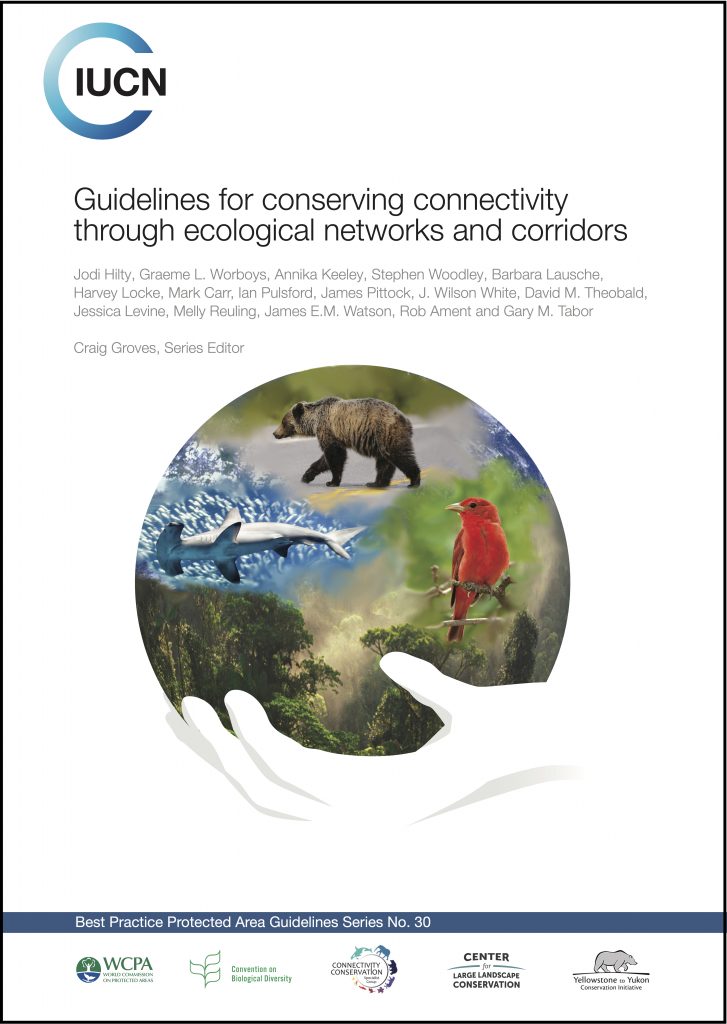First-Ever IUCN ‘Guidelines for Conserving Connectivity through Ecological Networks and Corridors’
The Center for Large Landscape Conservation is working to mainstream connectivity conservation solutions around the world that save biodiversity, increase resilience to climate change, and safeguard human health. To this end, the Center supports operation of the IUCN WCPA Connectivity Conservation Specialist Group (CCSG) that recently released the first-ever IUCN Guidelines for Conserving Connectivity through Ecological Networks and Corridors. The main objective of these Guidelines is to clarify and standardize consistent practices for the effective design, governance, and management of larger conservation networks of protected and conserved areas that are connected by designated ecological corridors.
What Is “Ecological Connectivity”?
As defined by the UN Convention on Migratory Species in February 2020, “ecological connectivity is the unimpeded movement of species and the flow of natural processes that sustain life on Earth.” This definition demonstrates the importance of connectivity conservation solutions, and everything they protect, including invaluable resources like water and nutrient cycling, pollination, seed dispersal, food security, and disease resistance.
About the Guidelines
The Guidelines are the culmination of over two decades of effort by IUCN, and the result of contributions from more than 100 experts in 30 countries. They now provide managers, policy-makers, and experts across the globe with insights into the science, definitions, and principles for planning and managing for ecological connectivity, as well as 25 case studies illustrating projects around the world.
Why It Matters
Connected ecosystems are more resilient. They support plants, animals, and processes to persist in an increasingly human-dominated world. However, more than half of the planet is now developed and this is threatening human well-being, accelerating species loss, and limiting nature’s ability to withstand the impacts of climate change. Safeguarding ecological connectivity is a proven conservation measure, and the Guidelines bring together the most current knowledge and proven practices to lead a new global effort to combat habitat fragmentation and protect intact ecological networks for conservation.
Key Messages
The Guidelines define the spaces meant to maintain, enhance, and restore connectivity; summarize best-available science; and recommend ways to formalize designated ecological corridors and networks with the following messages:
- Science overwhelmingly shows that interconnected systems of protected and conserved areas are necessary for species and natural processes to persist in the face of climate change;
- Communities and countries around the world are working to protect ecological connectivity, and more consistent global practices can advance legislation, policy, and action; and
- A coherent global approach to connectivity conservation allows for measuring, monitoring, and assessing the effectiveness of efforts to enhance biodiversity conservation.
To learn more about the Guidelines and the WCPA Connectivity Conservation Specialist Group, visit
www.conservationcorridor.org/CCSG or contact connectivity@largelandscapes.org
Additional Resources
- Press Release from the Guideline’s official release
- IUCN Guidelines for Conserving Connectivity through Ecological Networks and Corridors
For more information contact Aaron Laur, International Connectivity Program Manager, at aaronlaur@largelandscapes.org



